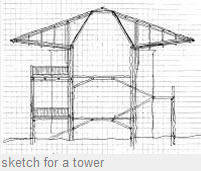|
Learn Sketching By Mastering PerspectiveThere are many times in modeling when the ability to “knock out” a quick sketch can save you time, money and give you the ability to capture a scene you would like to re-create in miniature. Unfortunately, until now, I have had to pass on these moments for what I thought was a lack of ability. I had a hard time drawing a box. There is a trick to sketching I didn’t really grasp until just recently and in a word, that is “perspective”.
Without proper perspective, your drawing is just an assemblage of lines and it would be difficult to model anything based on it. There are two features to keep in mind when trying to establish perspective in your drawing of objects like buildings:
~ They are smaller as their distance from the observer increases I learned a lot about this subject from YouTube, one of my favorite teachers. For instance:
Karl makes very good sense in teaching the idea of perspective in sketching and once you wrap your mind around the concepts, you need to move onto scale by producing your sketch on graph paper. One of my favorite sources of graph paper with differing sized blocks is the website: Incompetech which makes it a simple matter to print out your graph paper as needed. Once you are in the field you need to establish one single known dimension of say a window or door and then decide how many blocks of your graph paper equal that dimension whether it is height or width.
Once you have determined the height of a window at say 5 feet, determine how many five foot increments there are from the base of the building’s wall to the eaves line, or top edge. This is very similar to the so-called Pencil method. From a distance of about 25 yards, extend your hand and arm with an upright pencil or stick. Now move your thumb up the pencil until it aligns with about two yards (roughly a man’s height) of the building’s height. Once you have that point on the building’s wall. Continue up the wall in two-foot increments counting each. Multiply the total by six. The same method will estimate the length or width of a given wall. I say estimate because you do not have a need to have exact measurements to scratch build a model of the building. It will be your building, make it any height you wish unless of course your layout or diorama must conform to zoning regulations. |



 For accuracy’s sake you need to be face on to that window or door and as close to eye level as possible.
When you have determined how many blocks represent, say the height of a seven-foot door, you have the key.
For accuracy’s sake you need to be face on to that window or door and as close to eye level as possible.
When you have determined how many blocks represent, say the height of a seven-foot door, you have the key.